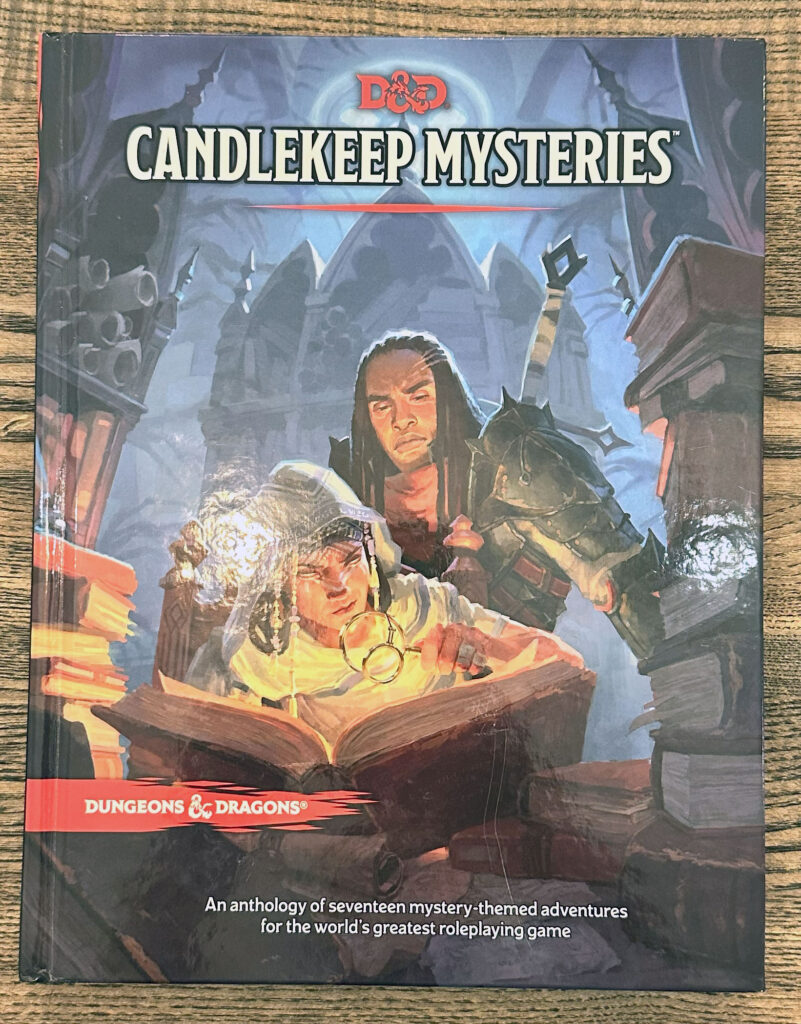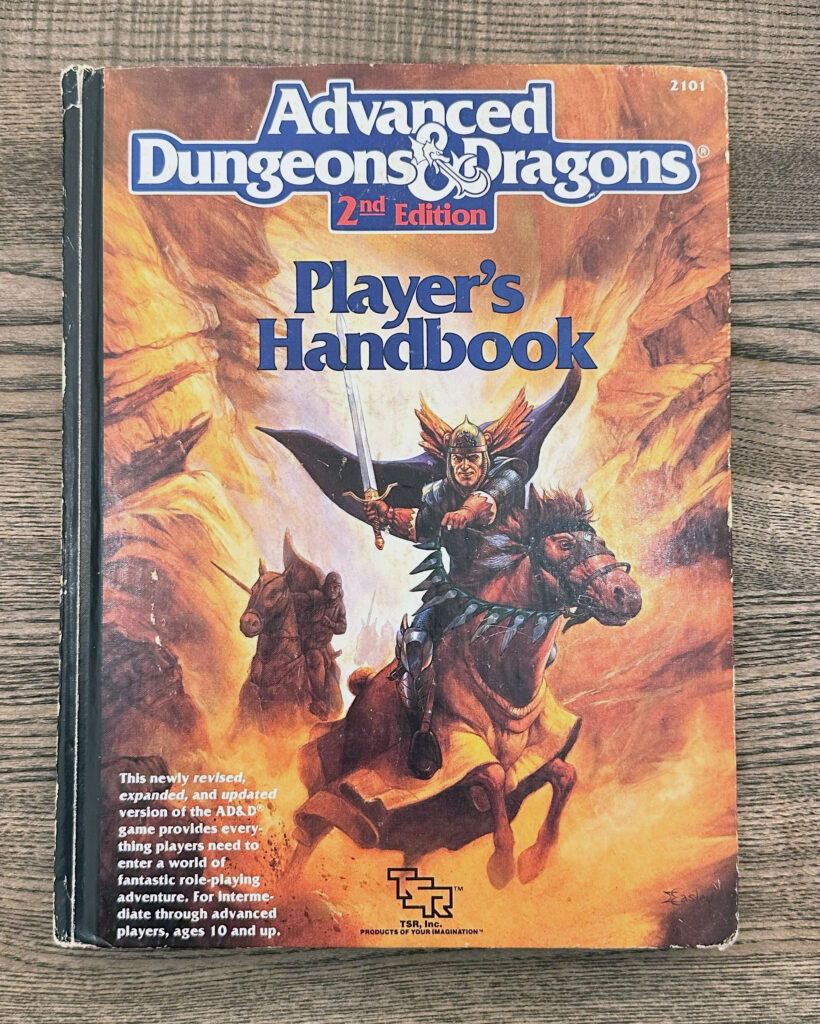We’re playing through Candlekeep Mysteries, in order, taking characters through levels 1-17. Here’s how I’m doing it.

My core group has been asking for more D&D for some time (years) now, and I haven’t had the drive to run any. I do like 5E, but a lot about D&D doesn’t really work for me – primarily all of the magic system, and the need for active suspension of disbelief when character power starts to escalate. I’ve looked at other fantasy games, and tinkered with my own take on compatible magic system. Then one of the players bought Candlekeep Mysteries and asked if someone could run it. I couldn’t say no.
(Since then the Planescape boxed set came out, and I do want to run that adventure. Let’s see how many years it takes before I get there.)
My plan for Candlekeep: revolving door principle, you can come and go as you please during the campaign, even if I expect most of the players to stick around for most of it. As is normal for me, it is forbidden to talk about characters who’s players aren’t there, and vice versa: when they’re again at the table, so are their characters, and we’ll pretend they were always there. It’s like a TV show with an ensemble cast – not everyone gets screen time in each episode.
We will play through the book in order, as the adventures are in ascending power level, 1-16 (there are two level four adventures). Using milestone experience levels, this becomes very simple: your character level matches the adventure we’re playing. I’m trying for at least a monthly session to maintain a good pace, preferably two. I’m expecting it to take us two years to get through all of it, if we do.
We’re now up to book (adventure) five of seventeen, ten sessions in. This is what I’ve learned.
Campaign structure
I expected the adventures to be single sessions. This hasn’t been the case, with the exception of the first adventure. We’ve run an average of two sessions per adventure. This slows us down considerably, but rushing things any more would make the game feel off to me.
I get the feeling that this is not meant to or expected to be run this way – with the party living in Candlekeep, coming across the books one by one. Instead, likely you’re meant to introduce an adventure or two into your own campaign. If I did that, I don’t think I could find use for more than a couple of the adventures, out of a book of seventeen.
There is little in the way of support of keeping the same characters from one adventure to the next. We had to agree with the players that their characters simply stick around at Candlekeep between the adventures, and if the players feel they need to talk about their reasons for doing so, they can, but it’s not required.
As there is a lot to get through, I asked all players to maintain focus on each adventure. Any personal stories would generally only get attention during downtime (I like the expanded rules in Xanathar’s Guide to Everything) at the beginning and end of an adventure.

Sword Coast
While I grew up with D&D, especially AD&D, and played a lot of the computer RPGs all set in Faerûn, I have never actually run a game set in the Forgotten Realms. I didn’t think I could run these Candlekeep themed adventures without looking at the wider world at all – Candlekeep itself being an iconic institution and location in the Forgotten Realms, after all.
I got the current edition’s Sword Coast Adventurer’s Guide (2015) to orient myself. I don’t like the current edition’s way of providing very slim books with minimal content, but it does add new character options and gave me just enough as a GM to get going in the region. I do wish there was at least a couple of pages more on all the primary locations. I guess I could look at the older edition books for more detail, but the way they’ve messed with the timeline is giving me headache (the Spellplague and the undoing of it) and I’d rather not deal with any of that.
While all of that is strictly background color for the adventures in the campaign, and in no way necessary to run the adventures, I like the ability to place the adventures on a map, and think about what else might be involved or nearby.
We’ve spent some time between adventures in Baldur’s Gate, and most of the major cities and powers have been mentioned in passing.
Character back stories
We currently have eight players. There’s a more stable core group of four players, and others come and go. While I want the campaign to focus on the player group’s (as opposed to the adventuring party they’re portraying) effort to play through the entire anthology, players do need some substance to their characters to have something to roleplay.
I made a list of important Sword Coast locations, and asked each player to tie their character to one or more of those, and then helped them come up with a reason for them to come to Candlekeep – looking for important information, most likely.
My plan was that once we get them all to Candlekeep, they’ll befriend each other and then just hang around in the library for reasons we’ll ignore in service of the bigger campaign goal of just playing through the adventures.
This did not work out. Especially since we started using the downtime rules in Xanathar’s, players have dived into their back stories and there’s a real wish to advance some of them. It’s starting to look like that despite my best efforts, there’s going to be a need for complete adventures outside of the campaign proper. The alternative is players whose investment in their characters, and thus the game, goes unanswered.
The other thing that’s happening – and I should’ve expected it, but I didn’t – is that continuity is starting to become a thing. Players do things that they expect to have an effect on the world, and again, I will need to return to these or the players’ emotional investment goes to waste.
I don’t normally run games like this. Usually the whole point is to focus on the character stories, and only provide a plot to function as a conduit for those personal stories. In retrospect, I should’ve thought about some other structure here, probably going back to how I usually run D&D: there’s a revolving spotlight turn where we decide together to spend time on a given character’s personal story in a session.
D&D Beyond leveling the playing field
Running current D&D is much easier with a D&D Beyond subscription. Being able to look up rules in seconds is great. Many of the tools are not that sophisticated, and I do long for the fan made tools we had back in 4E times.
However, the real big change is that no one at the table uses physical character sheets. This was a surprise to me. The D&D digital character sheets on the Beyond app are good enough for use at the table, and while some details are frustrating (house ruling anything, tracking encumbrance), the level of automation lowers the entry threshold for new players in a way I did not expect. There are two people new to D&D in my group, one of them brand new to roleplaying in general, and it feels like Beyond really democratizes the game. Creating a new character, leveling a character, or knowing what your options are on a combat turn are all easy to keep track of, regardless of your level of experience. It’s great!
Leave a Reply